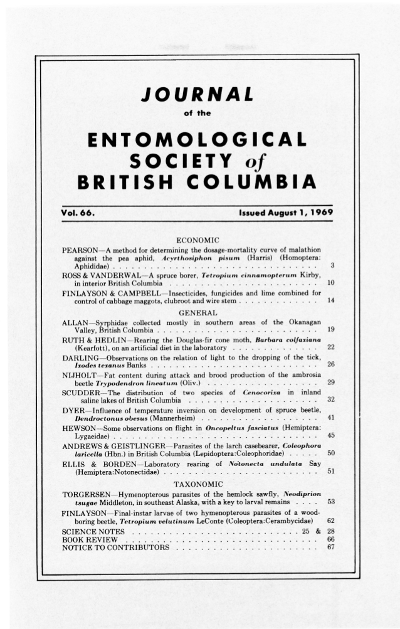The distribution of two species of <i>Cenocorixa</i> in inland saline lakes of British Columbia
Keywords:
<i>Cenocorixa</i>, saline lakeAbstract
The distribution of <i>Cenocorixa bifida</i> (Hung.) and <i>C. expleta</i> (Uhler) in British Columbia is summarized. The distribution pattern in a series of inland saline lakes in the central interior of the province is described. All water bodies are in the flight range of the two species, and seem to be colonized by them at random. However, <i>C. expleta</i> occurs and breeds only in saline waters, whereas <i>C. bifida</i> lives and breeds in fresh and moderately saline environments. <i>C. expleta</i> has been found only in waters with a conductivity between 3,900 and 29,000 micromhos/cm. (at 25∞C): <i>C. bifida</i> occurs only in waters with a conductivity between 20 and 20,000 micromhos/cm. The distribution appears to be correlated with salinity and not with other features of the environment such as area of water body, mean depth, maximum depth, etc.References
Brooks, A.R. and Kelton L.A., 1967. Aquatic and semiaquatic Heteroptera of Alberta, Saskatchewan, and Manitoba (Hemiptera). Mem. Ent. Soc. Canad. 51:1-92.
Chapman, J.D. et al., (ed.) 1956. British Columbia Atlas of Resources. Vancouver.
Edmondson, W.T. 1966. Pacific Coast and Great Basin, (in) Frey, D.G. (ed.) Limnology in North America. Univ. Wiscon. Press: 371-392
Fernando, C.H. 1959. The Colonization of small freshwater habitats by aquatic insects. 1. General discussion, methods and colonization in the aquatic Coleoptera. Ceylon J. Sci. (Biol. Sci.) 1:117-154.
Fernando, C.H. 1959. The Colonization of small freshwater habitats by aquatic insects. 2. Hemiptera (The water-bugs). Ceylon J. Sci. (Biol. Sci.) 2:5-32.
Hungerford, H.B. 1948. The Corixidae of the western hemisphere (Hemiptera). Kansas Univ. Sci. Bull. 32:1-827.
Johnson, C.G. 1966. A functional system of adaptive dispersal by flight. Ann Rev. Ent. 11:233-260.
Lansbury, I. 1960. The Corixidae (Hemiptera-Heteroptera) of British Columbia. Proc. Ent. Soc. B.C. 57:34-43.
Macan, T.T. 1939. Notes on the migration of some aquatic insects. J. Soc. Brit. Ent. 2:1-6.
Macan, T.T. 1962. Ecology of aquatic insects. Ann. Rev. Ent. 7:261-288.
Munro, J.A. and Cowan, I.McT. 1947. A review of the bird fauna of British Columbia. B.C. Prov. Mus. Spec. Publ. 2:1-285.
Oloffs, P.C. and Scudder, G.G.E. 1966. The transition phenomenon in relation to the penetration of water through the cuticle of an insect, Cenocorixa expleta (Uhler). Can. J. Zool. 44:621-630.
Rawson, D.S. and Moore, J.E. 1944. The saline lakes of Saskatchewan. Can. J. Res. (D) 22:141-20l.
Scudder, G.G.E. 1961. Some Heteroptera new to British Columbia. Proc. Ent. Soc. B.C. 58:26-29.
Scudder, G.G.E. 1969. The fauna of saline lakes on the Fraser Plateau in British Columbia. Proc. XVII Int. Congr. Limn. (in press).
Simpson, J.E. 1968. The flight muscle polymorphism in Cenocorixa bifida. M.Sc. diss. University of B.C. (unpubl.).
Sparrow, R.A.R. 1966. Comparative limnology of lakes in the Southern Rocky Mountain Trench. British Columbia, J. Fish. Res. Bd. Canada 23:1875-1895.
Downloads
Published
Issue
Section
License
Authors who publish with the Journal of the Entomological Society of British Columbia agree to the following terms:
-Authors retain copyright and grant the journal right of first publication with the work simultaneously licensed under a Creative Commons Attribution License that allows others to share the work with an acknowledgement of the work's authorship and initial publication in this journal.
-Authors are able to enter into separate, additional contractual arrangements for the non-exclusive distribution of the journal's published version of the work (e.g., post it to an institutional repository or publish it in a book), with an acknowledgement of its initial publication in this journal.
-Authors are permitted and encouraged to post their work online (e.g., in institutional repositories or on their website) prior to and during the submission process, as it can lead to productive exchanges, as well as earlier and greater citation of published work (See The Effect of Open Access).


